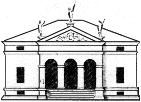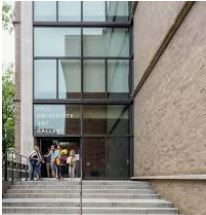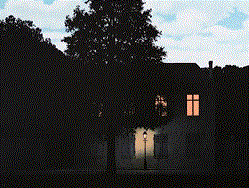 Welcome
WelcomeI submitted a reader comment to an architectural history website, concerning Mario Botta's Bianchi House at Riva San Vitale, and they've got it on their webpage for the house. Please check it out (at bottom of page).[2] The webpage is also lovely.
Aside: Thee good folks' website seems a bit messed up. They've apparently lost what I posted about Mario Botta, after I posted something about Louis Kahn (but now it's back[3]). So I will copy my Kahn comment here:
BRADFORD ROBERT MCCORMICK
JUNE 29, 2020 AT 10:48 AM
I feel Louis Kahn was a great architect. But only secondarily because he designed beautiful edifices (although he also did that, e.g., 1951/1953 Yale Art Gallery). Far more important, he designed and built for the enhancement of Everyman's (woman, child) life. A city is a place where a small boy, going from the workshop of one master carftsperson after another, may find something he *wants* to do for his whole life. (quoting from memory) That is a noble thought, something that truly deserves to be built, in my opinion.
The United States of America is a very rich country. I think it is an indictment that this noble person's life ended, if I may say it, dying "like a dog", in a public toilet in New York City's Pennsylvania railroad Station (from a heart attack). A limousine might have averted that tragedy. .America has many limousines and private aircraft. One of each should have been allocated to Kahn. ("Kahn was bankrupt when he died in that toilet at the age of 73, his small Philadelphia practice $500,000 in debt." Google search – America should have solved that problem.)
In Japan they have "living national treasures". America should rise to that, also. Kahn should have been a recipient of that designation. Only a truly great person, or a humble master bricklayer, could have a conversation with a brick.

In all my study of architecture, including particularly contemporary (1980/1990's ish) Japanese domestic architecture, and bracketing traditional Japanese architecture, there are only a very few houses in which I would really like to live. The house the philosopher Ludwig Wittgenstein designed for a couple of his relatives in Vienna is definitely one. Pierre Chareau, Bernard Bijvoet and Louis Dalbet's "Maison de Verre" (Paris, France) is another. Also: Mario Botta's Bianchi House at Riva San Vitale (a genuine Palladio villa would probably be out of any question[4]). I don't generally read poetry, except for haikus and Wilfred Owen's "Dulce et Decorum est...", because I often cannot parse the sentences or make sense of them. These houses are my kind of "poetry". I think it would be an honor to live in any one of them, and I hope each gives pleasure to its owner (whoever they are, and if the edifice has not been destroyed).
"A person incapable of creating anything can still find something to decorate." (BMcC)
"Lipstick on a pig." (Source unknown; Sacred to Postmodernists; Robert Venturi calls it: "Decorated sheds")

Postmodern architecture is criminal and degenerate (cf.: Adolf Loos's modernism manifesto: "Ornament and crime"). Robert Venturi's bad joke on the aged, Guild House (1963; Philadelphia, Pennsylvania), "considered to be one of the earliest expressions of Postmodern architecture... and [which] helped establish Venturi as one of the leading architects of the 20th century" (Wikipedia), looks it was inadvertantly spared from razing of a dehumanized "urban renewal" public housing project, except with a blatant boldface sans-serif lettered sign: "GUILD HOUSE" on the facade. My reader, note the detail of GUILD HOUSE, right. Venturi explains that the building is topped off with a gold anodyzed TV antenna which is a "symbol for the elderly who watch so much television". Not all aged Quakers are superannuated Archie Bunkers. Venturi has no appreciation of cultured persons' human life and should never have been allowed to become an an architect.
Maybe the facade is the worst part of the buiding but that would make sense because post-modern architecture is all about facades, so that the greatest amount of effort to make the building be postmodern would be expected to have been devoted to the facade, and consequenty the rest of the building may have escaped with less degradation. What distinguishes Postmodern buildings from Potemkin village buildings is that the Postmodern buildings have dreck instead of nothing behind their facades.
Icon image above shows a "decorated shed", the Holy Grail of postmodernist architecture.
It's a savings bank branch office made from a single-famiy house with a fake classical Greek temple facade pasted on the front. "Lipstick on a pig", except that that phrase very unfairly denegrates a porcine species. Postmodernist archecture effected a form of ideological orthodoxy years before the innovation of what would later be
called "Political Correctness" spread into the wider social surround of United States of America.
Frank Gehry's Case Western Reserve University Weatherhead School of Management (1997) is noted for frustrating police trying to catch a gunman on the loose in it, because the building had not a single straight line and thus the perp was able to keep eluding the police in a "cat and mouse game" which left a trail of blood through the building. (Danny Hakim, "Ex-Employee Held in Campus Attack", NYT, 11May03, p.A19) Above is a picture of this building. No! It's debris from a catastrophic derecho storm that hit Iowa in 2020 → but it sure looks like Gehry's building.
And while we're at it, the reason I did not get into any prestige Master of Architecture graduate school program (ca. 1982)[5] was that I have zip-zero freehand drawing skill, which would have handicapped me decorating sheds. Bauen (building), definitely (More is more). Wohnen (dwelling), well, everybody has to sleep somewhere each nite. Denken (thinking), not something we think about (NIMBY/NIH). Hubcaps are Relics of The True Cross.
At right is a paradigmatic example of decoration. It may antedate Mannerism, but, if yes, mannerist (and postmodernist) architects would celebrate it as visionary fenestration. It appears to be a non-load bearing replica of a lintel with a bas-relief image of a keystone, but there is no arch to support! If it really was a lintel, it would be weak in the middle or just have the keystone veneer stuck on its face. As much utility would be accomplished by embedding the keystone in an architect's forehead as a symbol that he or she or other has focal ("key") thoughts that abut on each side a wider contextual noematic horizon, what William James called "fringes". Or that inside the architect's brain case was material substance ("stone"). Alternatively, the architect could dress up as such a window for an AIA costume ball at the "Queen of Mean" Leona Helmsley's Palace Hotel. Or why not use this picture in the 2003 United States Department of Defense (DoD) Most Wanted Iraqis playing card deck, for the Joker? To decorate is to make a thing advertise it is something it is not: To decorate is to lie. Lie-di-da!
A test: Is this a real house or is it a Potemkin Village house or what? (Note: this is a real test. I (BMcC), your instructor, do not have the answer.)
The great humanistic architect Louis I. Kahn died the way I think postmodernism architecture in toto should meet its end: like a stray dog (Kahn died of a heart attack in a men's room toilet stall in New York's Pennsylvania train Station and his body was taken to the New York City morgue and identified "tentatively" from his passport).
 Yale Art Gallery (1953) New Haven Connecticut. Modernist architecture, with no decoration, but with triangulated concrete gallery ceilings which subtly reveal the building's infrastructure conduits above, to an estheticaly pleasing effect.">
Yale Art Gallery (1953) New Haven Connecticut. Modernist architecture, with no decoration, but with triangulated concrete gallery ceilings which subtly reveal the building's infrastructure conduits above, to an estheticaly pleasing effect.">
Louis I. Kahn's Yale Art Gallery (1953).
Oh! What a relief it is![6]
I've found the building I was looking for but not yet the detail I'm looking for: Vanna House. Vanna House is the early (1962-64) postmodern house Robert Venturi designed for his mommy.
The detail I have not found is the following. At this point it is for me only a possibly false recollection: Robert Venturi solved all the possible psycho-sexual problems of the marital bed in the following way. The master bedroom is on the 2nd floor of the house. Venturi split the bed down the middle, lengthwise, so that there were two equal sides, one for each person of a couple. Venturi opened up a slit down the length of the bed, and installed a glass pane in the floor, under the slit, for the full length of the bed (probably no wider than the window in some prison cells such as in the SuperMax in Florence Colorado USA, maybe 6 inches wide?). Consequently, anyone on the bed can look down into the living room on the floor below at any time, no matter what Y-axis offset from the head of the bed the person's head is at, provided their X-axis position is near the middle of the bed.
"One thing leads to another...." / "Tempus fidgits" (BMcC)
I believe that modernism is in a certain sense unsurpassable, for how can anything surpass self-reflection, which is the taking up of what is, whatever it is, into self-accountable re-new-al (making whatever it has become new again): Here is what I've got, and this is what I propose to do with it, pending realtime feedback and subsequent course modifications. Genesis 1:31: Somebody wrote that God finished making the world and He liked what He's done. What am I going to do with that cultural artifact? Covid-19 may kill me (that would not matter to me, since then I would either be not or be some place else than this earth), or put me in the hospital and put out of commission my ability to read or write anything which possibility concerns me very much. What am I going to do about that? Answer: Write this.
But there is still a kind of after-modernism which is not a devolution to decorating sheds and tearing down statues of men who happened to have exited birth canals at certain GPS+UTC coordinates: The creative re-appropriation of what seems best in everything and everybody I can learn anything about, from Heraclitus to (FLOTUS №45) Melania Trump (when there is anything good in them, otherwise trying to prevent against their further impinging on anything). All the giants who were modernism are, in 2021, dead (Wassily Kandinsky, Adolf Loos, Mies van der Rohe, Eero Saarinen, Alvar Aalto, Edmund Husserl....), so, by definition, we today cannot be anything other than some kind or other of post- modernism. The question is: what specific kind?
As Robbie has written: Shakespeare lived an ordinary life, just like me. I do not look at Mario Botta's Bianchi House at Riva san Vitale just as a possible correct name-the-object-in-the-picture answer on a college art history examination (although it might also be needed for that if I was in Vincent Scully lecturing's Yale College Art History 10 course, 1964; did that man have no understanding at all that art is not just something for self-conceited university employees to get adulated for simpering about?). I think of the life I could live there or in some house I could try myself to design in post-Yamamoto extra-Fukushima Japan.
I have a GA Architecture periodical (1983) with pictures of a certain small contemporary Japanese house where I fantasize thriving while yet I would be alive and not yet Alzheimer's. Probably any Robert A.M. Stern MacMansion mortagee could afford it with cash to spare. I think about the life I could build in that austere treasure box, and also about the shallowness of the MacMansion as built: just vacant (perme-vacationing?) spaces not to human scale maybe with historicist decoration? I imagine how I might make the MacMansion more livable if I had the great mixed fortune of owning but not being able to sell it and having to live in its big empty volumetric spaces aka: rooms. It could be fun, especially if I had the extra money to make architectural modifications. Disdaining is one form of [re-]appropriation.
People whimper for the past? I do too: Giovanni di Dondi, a man who, in the 14th Century, crafted an astronomical clock that took him 14 years to make and he had to make many of the tools he needed to make the clock and he documented his work so well that even though the original did not survive (I think I read somewhere that was trashed for scrap, but I may be wrong there), in the 20th century a replica was reliably re-produced. That's a past I can related to, not some faux-tribal members doing parochial-ish social customs that presumably are not condemned in any university's ethnic-studies department's curriculum (FGM, any of you ladies? and what's so great about circumcision, either, with or without blood-sucking by the cutter?). On the other hand, why should General Robert E. Lee be trashed because he believed like his contemporaries, in slavery, and not just be condemned as a traitor to his country? Thomas Jefferson, another slave owner, was not a traitor: he just committed the crime of living in his time. Do all those who get off on dissing slave owners also accuse that 2021 employers of wage-labor differ from slaveholders only in that they rent instead of buy, and that when they mistreat their "human resources", the repair bill is on the laborer not the employer of labor, because the laborer is not a capital asset? Maybe those who condemn slave owners should study such cases as Epictetus and judge all concerned by criteria that could therefore have been known to persons who came a millenium later from memory, not applied ex post facto ?
My (BMcC) post- of modernism would be a social world where every person would become a Giovanni di Dondi of his or her or other's desired area(s) of focusing in their life, be it clock-making or cardiac surgery or brick-laying or whatever (probably not Whopper-flame-broiling and such, although maybe hand-made goat cheeses from a flock of beloved goats where the cheese maker knows each of his or her goats by name). That, I think, is a way of going beyond modernity to which everyone in The Bauhaus would say Amen.
The point here is that I am talking about a formal unsurpassability, which, empirically entails always surpassing wherever one is. Heraclitus wrote:
"The meaning of the river flowing is not that all things are changing so that we cannot encounter them twice but that some things stay the same only by changing."

Some flotsam that clogs the river eventually breaks free to clog the river again a little way downstream: melanoma metastases of psycho-social life. Mr. Robert C&CinA ("Complexity and Contradiction in Architecture") Venturi, LFLV (Learned From Las Vegas)? Did I ever see a Mail Pouch tobacco ad in one of your shed decorating books, or would some honest barn decoration painting be beneath your reverse / perverse snobbery? Quack!
Yes there is all sorts of bad architecture, and POMO is surely some of the worst of it in our time (see example here). But now I've come across something else really bad: a house that wouldn't fit in anywhere, athuhg it preobably should be in a gated community of MacMansions. It's modernist design, but it's not just decontextualized like maybe some of Mies's work, but anti-contextual: It rejects its site. It is is apparently sited somwehere on a road near a traditional farmhouse or something like that: (Click here to see).
This thing looks like it's something bad that got beamed down in the Starship Enterprise's freight transporter (never shown on the tv show) and is still in it, mostly here but not quite fiished being beamed down, and may yet go back where it came from? All it needs is to alternate with the Baby Trump balloon in its place. What's the point?
"Bauen, Wohnen, Denken"" (Martin Heidegger)
What is an apartment? It is a part of the polis. And it is also apart. It is the synthesis of apparent opposites: privacy and community.
A Levittown floats away into air and evapidorates. Mow the grass, cut your hair, Mr. Jones. You're keeping up, old boy. Got any time to spare? You're on home release from the office. "Daddy! Daddy! Daddy!" Life was completer in your 1953 Chevrolet before Mr. Nader spoiled everything with seat belts, wasn't it? What do you have to chau ffeur it all? Gotta take the chip off the old block to T-ball, and Suziecue to ballet, wher you can say hi to your stockbroker who's brought hs little girl there too too. An oil change every 3,000 miles or is it 6 months, whichever comes first? Weekends were made for Michelob. But every Sunday i followed by its Monday, you know.
The American dream of a single family mort-gage ("mort" means death) on as big a grassy lawn as possible divides without uniting but still does not provide privacy, since it's easy for neighbors to spy on each other across the open interhouse space. It often does remove arable land from productive social use, as if nobody needed farms, yes? I have a neighbor whose husband wanted privacy so he bought a second lot to not build on. The land is mostly undeveloped trees and brush. Looking out from her house it is almost possible to imagine nobody else lives anywhere around. She is from French pre-World War II money, and her home is like a little piece of the French countryside. Charming and very unusual in suburbia, yes? The large house where she grew up in France was inside a small village, physically connected to her family's place of business. I like to visit her and imagine I am in the world of Eugene Atget not Metro North commuters.
Why do Americans lust to mortage their lives? Of course not all do. But how many pine for a neighborhood bistro at day's end?[7]
If you had to work as a waiter or waitress, would you rather work in the above family resaurant or in "Eatin' good in the neighborhood" Applebee's, or, a fortiori, a McDonald's hamburger restaurant? I would like to live in a lovely apartment ("flat"), maybe a third-floor walk-up above the bistro, or a few doors away, to be able to walk to and from not have to drive an automobile. Ms. Shore! Isn't life completer without a 1953 Chevrolet?
